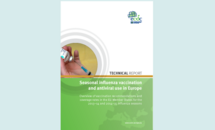Seasonal influenza vaccination in Europe – Vaccination recommendations and coverage rates for 2013-14 and 2014-15
Overview of vaccination recommendations and coverage rates in the EU Member States for the 2013–14 and 2014–15 influenza seasons.
Executive Summary
In Europe, influenza occurs in regular annual epidemics in the winter season. Annual influenza epidemics are associated with high morbidity and mortality. Severe illness and complications are more common in certain risk groups. These include those with chronic medical conditions (e.g. cardiovascular, respiratory, renal and hepatic diseases, diabetes mellitus, immunosuppression due to disease or treatment, obesity, children and teenagers on long-term aspirin therapy) and individuals 65 years of age and above. The main public health intervention to prevent influenza is vaccination. To protect vulnerable individuals and reduce transmission, vaccination is also recommended for healthcare workers (HCWs).
The aim of this survey was to provide an update on seasonal influenza immunisation policies and obtain vaccination coverage rates in European Union (EU) and European Economic Area (EEA) Member States for the 2013–14 and 2014–15 influenza seasons.
A standardised questionnaire was developed and made available as an online survey. The survey was rolled out in December 2015. Experts in each Member State entered data directly online. Of 31 Member States invited to participate in the survey, 30 responded. Luxembourg did not respond to the survey. The United Kingdom provided data separately for England, Northern Ireland, Scotland and Wales.
Of 30 responding Member States, all recommended seasonal influenza vaccination to older age groups. Nineteen of them had influenza vaccine recommendations for those aged ≥65 years. Hungary, Germany, Greece, Iceland, the Netherlands and Portugal recommended vaccination for those aged ≥60 years; Malta and Poland recommended vaccination for those aged ≥55 years; in Austria and Ireland, vaccine was recommended for those aged ≥50 years; in Slovakia vaccine was recommended for those aged ≥59 years. Nine countries recommended vaccination for children/adolescents <18 years of age: Austria, Estonia, and Poland recommended vaccination for children and adolescents in all age groups; Latvia and Slovenia for children aged ≥6 months to 2 years; Finland for children ≥6months and up to 3 years; Malta for children between 6 months and 5 years, and Slovakia for children aged ≥6 months to 12 years. In the 2013–14 season, the United Kingdom recommended that children aged 2 to 3 years should be vaccinated, a recommendation which in 2014–15 was extended to 4-year-olds in England, to 2–11-yearolds in Northern Ireland and Scotland, and to 4–11-year-olds in Wales).
Of 30 responding Member States, 29 recommended influenza vaccination for HCWs; 24 of these had recommendations in place to vaccinate all HCWs; four recommended vaccination for only certain HCWs.
In Northern Ireland and Scotland, vaccine was offered to all HCWs, while in England and Wales recommended that HCWs in direct contact with patients should be vaccinated.
All Member States recommended that people with immunosuppression due to diseases or treatment, metabolic disorders, chronic pulmonary, cardiovascular and renal diseases should receive influenza vaccination. Twenty-seven Member States recommended that people with liver disease should get vaccinated, and 28 did the same for HIV/AIDS. Fifteen Member States recommended that people on long-term aspirin use (children <18 years of age). Nineteen Member States had recommendations in place to vaccinate those with morbid obesity.
Of 30 responding Member States, 27 recommended vaccination of pregnant women. Twenty-five Member States recommended vaccination of all pregnant women, while two Member States recommended vaccine only for those pregnant women with chronic medical conditions. Twenty-one Member States recommended influenza vaccination for pregnant women in any trimester of pregnancy.
In 2014–15, vaccination coverage rates, which were measured through an analysis of administrative data or estimated by survey methods, were known in 25 Member States for older target populations and ranged from 1.0% to 76.3% (median 45.5%). The coverage among healthcare workers was known in 13 Member States and ranged from 5% to 54.9% (median 24%). The coverage for those with chronic medical conditions was provided by seven Member States and ranged from 21% to 71.8% (median 49.8%). The coverage for pregnant women was known in five Member States (0.3% to 56.1%, median 23.6%). Three Member States were able to report vaccination coverage rates for residents of long-term care facilities (96.6% in Ireland, 72.2% in Slovakia, and 77% in Portugal).
The predominant payment mechanism for influenza vaccinations1 , as reported by Member States, was through national health services (or equivalent) for those population groups for whom seasonal influenza vaccine was recommended (children, adolescents, adults, those with chronic medical conditions, pregnant women, HCWs and members of closed communities).
Eight Member States recommended pre-exposure chemoprophylaxis in influenza outbreak situations for unvaccinated residents of long-term care facilities and unvaccinated healthcare workers (HCWs). Pre-exposure chemoprophylaxis was also recommended in seven Member States if the vaccine did not match the circulating influenza strain. Post-exposure chemoprophylaxis was recommended for unvaccinated close contacts of at-risk individuals (six Member States) and HCWs (five Member States). Treatment of inpatients was recommended in 21 Member States for severe, complicated influenza-like illness (ILI) and in 19 Member States for progressive ILI. Outpatient treatment was recommended for those <5 and those ≥65 years of age in five and 14 Member States, respectively. Sixteen Member States had recommendations for individuals with chronic medical conditions, 11 for pregnant women, and 12 for residents in long-term care facilities.
In conclusion, the results of the survey indicate that most of the Member States have clear recommendations which population groups should receive seasonal influenza vaccine, i.e. those with chronic medical conditions, pregnant women, older age groups, and HCWs. However, there was a notable discrepancy between having recommendations and the ability to monitor and report vaccination coverage among those with chronic medical conditions and pregnant women: less than a quarter of EU/EEA Member States are able to do so. Just under half of the Member States were able to report on vaccination coverage for HCWs.
Although there has been widespread consensus for many years that the older age groups should be vaccinated, the EU target of 75% was reached in only one Member State in the 2013–2014 season, and in the 2014–15 influenza season not a single Member State reached the target. As the ability to monitor vaccination coverage is a key component of any vaccination programme, all Member States may need to reconsider their approach in order to collect more comprehensive and accurate information on vaccination coverage for all targeted population groups. Member States that do not monitor vaccination coverage among older age groups are encouraged to implement age-group-specific coverage/monitoring systems in accordance with national recommendations to enable them to track their progress or identify obstacles to achieving national and EU targets.
Most countries recommend antiviral use for treatment, however recommendations on antiviral use for prophylaxis of influenza are not common among Member States.
Download








